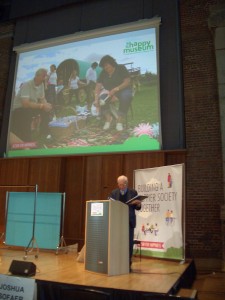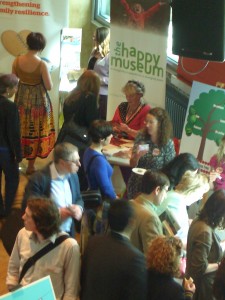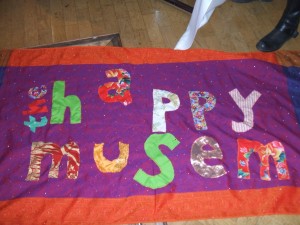Finding the other ‘U’ – Happy Museum and Action for Happiness launch
IN 2011 The Happy Museum took its place at the launch of ‘Action for Happiness’ in St Luke’s Old Street, London – proudly we might add, given our Happy Museum stall was one of 14 alongside New Economics Foundation, Young Foundation, Happy City and others. Our task for the day, apart from letting as many people as possible know about the wonderful Happy Museum Project, was to sew a Happy Museum Banner. We’d been asked not to just bring piles of brochures and thought this would place us perfectly in a ?flow’ zone of contented shared doing – and it did – more or less as you shall see…..
Action for Happiness is a major public experiment headed up with passion by Messrs Layard, Mulgan and Seldon that hopes, as it rolls along, to become an influential popular movement. ?There needs to be a shift in values towards a more trusting, giving and connected society, that’s what we’re hoping to catalyse’ said AfH director, Mark Williamson. The day brought together a broad spectrum of sectors and interests – public health workers, psychologists, economists, media, corporate ?human capital’ departments, teachers, community projects, journalists – proving that ?well being’ and happiness is a growing interdisciplinary area.
The launch felt inspiring and risky in equal measure. Citing psychological research and the facts like the use of anti depressants having gone up by 40% in the last 4 years, it outlined the need to pay attention wholesale to our experience of living. Unhappiness triggers a vicious circle of social malaise; whilst happiness triggers the opposite. Purposeful, helpful, contented people know what is meaningful in their lives and turn outwards to make a positive contribution to society. Material wealth alone doesn’t make us happy and psychological research shows we now understand much more about what makes us happy (social connection, helping others, being part of something larger than ourselves, not being stressed and so on.) ?Happiness is a decision’ AfH states.
As others have noted (Sam Thompson at nef, Madeleine Bunting in the Guardian) this is a premise that can be regarded as simplistic ? as well as prone to pitfalls. What is at best, a timely and essential look at what makes us live well together, at worst can smack of a happy clappy cult.
So far so good, but as we listened further to an impressive array of people and projects joining together to launch this initiative, we wished intently that we had had a chance to speak up about the Happy Museum! We felt frustration with the lack of framing and context for the proceedings. This is what we would have added and expanded and is laid out clearly in the Happy Museum paper (written in association with nef).
Name the planetary context from the outset
The global challenges we currently face ? financial meltdown, resource scarcity, climate change ? are evident. Whether we acknowledge this directly or not the reality is there – and affects us at an existential level. The links between these challenges and our collective wellbeing, both in cause and in effect, need to be made explicit. We have learnt that to name these realities upfront in public gatherings, nails in one go where the challenges lie – and more importantly gives real context to the opportunities to be seized.
Our wellbeing is collective and includes unhappiness
In the context of the economic and environmental challenges we face, there are literally millions of solutions, but they need to be tackled collectively and they need to be tackled with a sense of adventure and historic human purpose. Joanna Macy’s Work that Reconnects along with deep ecologists, eco-psychologists and others gives a clear explanation of how our current situation in the world (where the human species is both victim and perpetrator of the destruction of the biosphere) cannot be reduced to a personal pathology. Our sense of wellbeing is collective and includes experience of the deepest grief at the loss of certainty in our future. There are ways to transform these feelings creatively into happiness but only if we admit the depths of feeling involved and tap into something richer and deeper.
The truth is in the projects
Interestingly, a more honest appraisal of what could be making us all unhappy in the first place, came through when practical ?happiness’ projects were described in particular The Happy City and DIY Happiness where global issues were referenced – ?wellbeing sits in the context of global warming and sustainability’ for example – but this was late in the day and many had left at this point. We look forward with interest to hearing more of the many projects which will doubtless emerge from the energy created by the AfH movement.
The Happy Museum itself has £60K of commissioning funds to invest in projects that can test out ways in which happiness and well-being can be explored. These will create collective public experiments within museum and gallery settings to rehearse new ways of living – they will hopefully frame our unhappiness alongside our happiness and show how ingenious, compassionate, collaborative creative and adventurous we all can be. For background and context on the Happy Museum project see Tony Butler, Project Director, speaking at the launch event earlier this month.
But we have a way to go.
When we unfurled our banner at the end of the event we saw that it nearly got there but needs more work? it hadn’t quite got the hang of collaboration and needs another ?U’?




